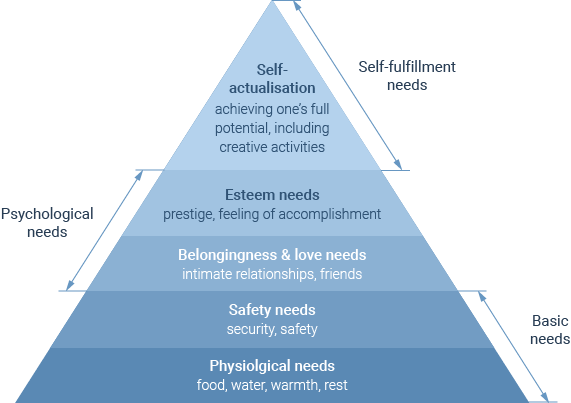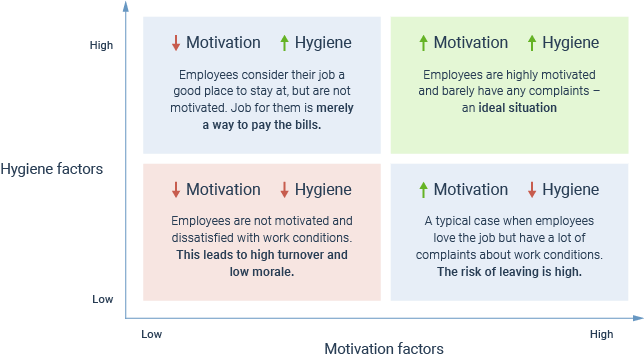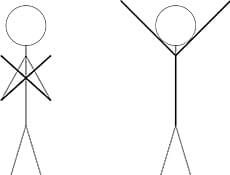Today’s business world successfully applies different theories of motivation, as each of them has specifics, pros and cons

For centuries, employers have been puzzled by a question on how to motivate employees to perform work better, faster, and with less effort.
Low motivation has always been a major concern for managers, as it leads to low engagement, poor performance, and, eventually, high turnover among employees.
And moreover, motivation directly correlates with happiness and job satisfaction.
Theoretical concepts of motivation provide different explanations of how it works. The common point is, motivation is something that can be influenced and managed.
Most theories of motivation are widely used in management for improving individuals’ and teams’ work results.
Maslow’s hierarchy of needs theory
This is one of the most famous motivation theories that can be applied to any area of life.
The concept developed by Abraham Maslow in 1943 suggests that human needs are classified in a hierarchical system, ranging from physiological needs such as food and sleep, to self-actualization, and as soon as the lower-level need is satisfied, it no longer works as a motivator for the person.
As long as lower-order needs are not satisfied, higher-order ones are not yet relevant.

Despite some criticism of the theory, it received worldwide recognition and practical use in many fields, including business and team management.
Being intuitive and easy to understand and apply, the hierarchy of needs is considered an important factor to take account of when managing employees’ motivation.
How to apply this in the workplace?
Many managers and business owners are still not taking the upper level of the pyramid into account. Their approach, instead, is focused on the lower levels – which is not bad, as it results in such benefits as high income and job security.
However, better results are achieved where self-actualization level is involved.
This theory, applied to the workplace, additionally emphasizes the importance of meaningful work.
Also read: 5 analytical tools that entrepreneurs can use to scale
Besides offering competitive salaries and flexibility, it’s worth creating roles where people understand the importance of their actions and decisions and are motivated by having meaningful work to do every day.
Herzberg’s motivator-hygiene (two-factor) theory
Also known as two-factor theory, this concept divides motivational factors into two large groups. The first group, motivators, are intrinsic to work and increase employees’ levels of satisfaction and motivation.
The second group, hygiene factors, are extrinsic to work and influence workers’ dissatisfaction: they affect the number of complaints and can retain or not retain employees at their positions.
The following factors work as motivators: challenging work, meaningful work, given responsibility, involvement in decision making, etc.
The following factors work as hygiene factors: salary, job security, interpersonal relationships at work, benefits, administrative practices, etc.
How to apply this in the workplace?
Besides the obvious conclusion, trying to reduce the factors that increase dissatisfaction and strengthening those that increase satisfaction, remember the following possible combinations according to Herzberg:

McGregor’s participation theory
This approach is also known as Theory X and Theory Y that describes two different approaches to people’s attitude to work. The two models emphasize contrasting behaviour and action drivers that cause the opposite attitude and management styles.
Theory X describes typical workers as people who have little to no ambition, tend to avoid responsibility, and are focused on their individual goals.
Also read: Marketing tools and tips to grow your business online
Managers, as a consequence, are focused on overcoming employees’ laziness and pursuit of their self-interest by closer supervision, punitive measures, complete management of all work aspects, and direct rewards for the desired behaviour.
Theory Y assumes that employees are motivated to achieve team goals, enjoy what they do, and don’t need direct rewards or punishments to work better.
Theory Y managers are focused on delivering team goals to their employees, building healthy relationships at the workplace, and granting sufficient autonomy to workers.
The mnemonic rule is shown in the picture below: Theory X workers refuse to take on work and responsibility, Theory Y workers welcome it.

How to apply this in the workplace?
These two theories help choose an appropriate management style. And while Theory Y seems to be ideal, it’s not always possible to follow it.
Most often, the combination of both is used, with proportions depending on employees’ personality traits, manager’s leadership style, workplace conditions, organizational regulations, etc.
The two theories should not be seen as two ends of the same concept – more like two separate concepts themselves.
McClelland’s need theory
Opposed to the hierarchy of needs, this theory describes key motivators as separate, non-hierarchical needs: the need for achievement, need for power, and need for affiliation.
Need for achievement (n Ach) defines employees’ motivation to excel, to do better work, and to compete with the standard of excellence.
Need for power (n Pow) is the need to have an impact on others, to change people, and to make a difference. Need for affiliation (n Aff) is the desire to establish friendly relationships with people around.
How to apply this in the workplace?
Identifying the needs of each employee and assigning appropriate roles to them helps increase their motivation. Matching personal traits with job responsibilities is a proven way to improve work results and make people excel at their jobs.
Also read: How to make yourself work when you don’t have any motivation
For example, managers’ positions are a perfect fit for those who have the need for power as their leading motivator, analytical jobs suit those whose main motivation factor is the need for achievement and positions where communication and soft skills matter are a great choice for people with a strong need for affiliation.
Job characteristics theory
This theory, developed by Greg Oldham and Richard Hackman, is a theory of work design, focused on job enrichment. Its original version represents a model of five key job characteristics that influence motivation, satisfaction, and performance:
- Skill variety: the degree to which job responsibilities require mastering skills and developing talents. This adds personal interest to the job by involving self-development and actualization.
- Task identity: the ability to perform a task and achieve a visible outcome. For employees, this means being involved in the entire work process and seeing the importance of their work for the team’s result.
- Task significance: the effect of the job on other people’s lives. Being able to improve other people’s wellbeing makes a job significantly more meaningful.
- Autonomy: freedom and independence provided to an employee to perform their duties. It ensures the ability to self-actualize through applying own efforts, initiatives, and decisions to the work process.
- Feedback: the ability to know the results of one’s work and be aware of how its outcome is perceived and evaluated. Clear and actionable information on the employees’ work results increases their ability to improve performance, technique, or workflow to achieve better outcomes.
How to apply this in the workplace?
This theory is focused on analyzing everyone’s roles and finding ways to increase work meaning.
Making sure everyone realizes the impact of their work on the common bottom line, on other team members and customers, increases employees’ motivation, reduces turnover and improves teamwork.
Summary
Sticking to just one theory can hardly be a productive way to improve employees’ motivation.
The only working way is to learn more about each approach, find what resonates with your own management style, and adjust theoretical knowledge to real-life workplace conditions.
Taking action helps build an individual leadership style that allows to reveal team members’ motivators and use them to achieve better personal and team results.
–
Editor’s note: e27 publishes relevant guest contributions from the community. Share your honest opinions and expert knowledge by submitting your content here.
Join our e27 Telegram group here, or our e27 contributor Facebook page here.
Image Credit: Kristopher Roller
The post Theories of motivation explained for business appeared first on e27.